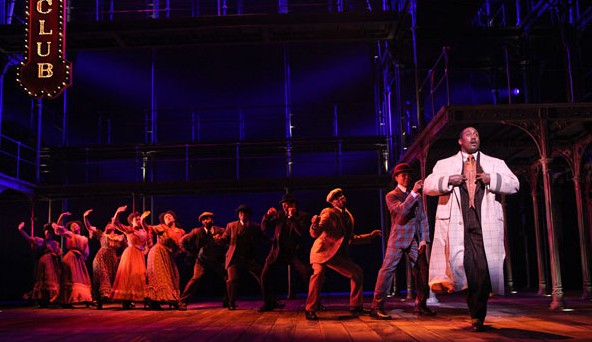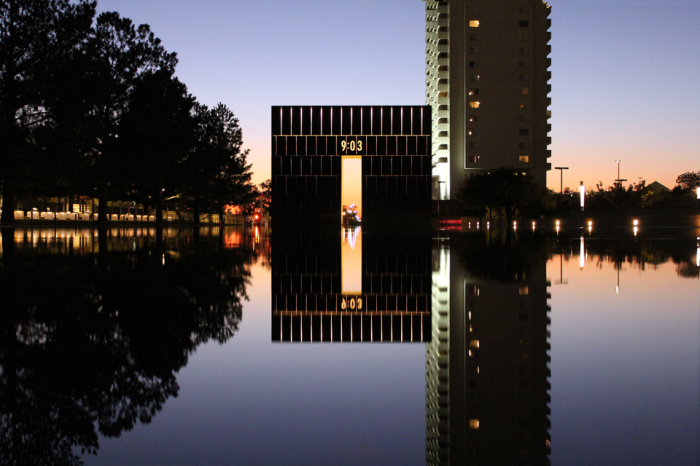I was cooking in my kitchen. I don’t remember what I was cooking- probably pasta. It was in the beginning of my spring break so I didn’t have to go to work the next day. I heard my wife saying from the couch in the next room, “Aaron, you need to come look at this.” I wiped off my hands and walked over to her, and she turned her computer to me and pressed play.
“There will never be a n**ger SAE! There will never be a n**ger SAE! You can hang him from a tree, but he’ll never sign with me, there will never be a n**ger SAE!”
I looked up at my wife. My eyes were wide. This was bad.
***
Three weekends ago, the University of Oklahoma put on a university-wide production of Ragtime, an epic musical about the early 1900s in America. Ragtime is a sprawling show with a lot of characters and complex themes. It’s the kind of show that, if done wrong, has the potential to be an epic flop. But the OU School of Musical Theatre has proven time and time again that they have the will and the talent to pull off complicated productions. In the past few years, I’ve seen their versions of Sunday in the Park with George, La Cage aux Folles, and The Drowsy Chaperone– all nuanced shows on the page, and OU’s productions of them were consistently wonderful. But they reached a new level of quality with this production of Ragtime. It’s not that they did anything noticeably different; the acting was predictably great, the sets were beautifully constructed, and the costumes and props were appropriately elaborate. This was business as usual for OU Theatre.
But Ragtime as a show reaches higher than anything the school has previously done. The themes are more all-encompassing, the story more universal, the production more ambitious. Terrence McNally’s book intertwines multiple plot lines with several historical characters intermingling with well-drawn originals. The songs (music by Stephen Flaherty, lyrics by Lynn Ahrens) combine to paint a mural of American culture as a tumultuous melting pot. This makes Ragtime a heavyweight show for any organization to tackle, let alone a program at a school mired in racist controversy.
One thing besides the show’s inherent quality that makes Ragtime stand out from most other Broadway shows is the fact that one of the storylines is a specifically black story. Broadway, like America’s other mainstream pop culture media, is notorious for failing to represent the wide span of cultures between America’s shores. African-Americans are vastly underused on the Great White Way, giving the industry’s nickname a sinister double meaning. It’s not that there haven’t been musicals with stories about black culture. But like TV and movies, musicals have told white stories for the majority of their existence.
So it was refreshing when I saw the first chorus of black actors come out during the opening number. There were a lot of them; more than I was used to seeing onstage at the same time, sadly. I knew in that moment that we were getting a story that would not only include black people but be about black people. And indeed, Ragtime tells the story of a black couple who, through tragedy both circumstantial and intentional, become caught up in violent racism and violent retaliation. It would be impossible for any work of art to cover the spectrum of black experience in America, but Ragtime feels like it comes close.
That the School of Musical Theatre chose Ragtime at this point in time should not be lost on anybody. If the decision was coincidental after everything that happened- not just the SAE fallout, but the continued conversations surrounding diversity on campus and the tension therein- then it was extremely fortuitous timing. Regardless of the program’s intent, the effect the show had was cathartic. To have so many African-American actors participate in the telling of a story that was distinguishably theirs was precisely what the Oklahoma campus needed. The process of healing had already begun, and it’s far from finished now, but Ragtime was a step in a powerful direction.
***
We were on campus late in the morning on the day of OU’s homecoming, waiting for the parade to go by. More importantly, we were waiting for two of our friends to get engaged. They had been together for a really long time, since high school, so it was a momentous occasion, to say the least, and we were all really excited. I glanced at my phone for a second and saw I had a notification from Twitter. I unlocked my phone and stared at it in speechless disbelief.
“@NewsOn6: Von Castor tells us two people are dead and numerous others injured at homecoming parade.”
I immediately showed my wife. Our parade had just begun. Our friends were newly engaged. And tragedy had just struck Stillwater.
***
The next night we were in Tulsa to attend a Ben Rector concert at Cain’s Ballroom. He had just released a new album in August, which I love; it’s like peak James Taylor circa Sweet Baby James. Ben Rector is from Tulsa and performed his first concert at Cain’s. So it was a homecoming of sorts for Rector, the same weekend as our homecoming and as OSU’s.
We had VIP tickets, because Rector is my wife’s favorite artist; she’d seen him at least four other times before this. VIP meant we were able to watch him give an acoustic performance of two of his songs. He answered questions and posed for pictures with each VIP ticket holder. It was a really cool experience. He seems like a very warm, genuine person. But his actual concert was even better. He performed a healthy amount of new songs and old hits, including performances with his full band as well as solo iterations of his quieter songs. Of the Rector concerts I’ve been to, this was his best backing band. Even on songs that sound production-heavy on the albums, the band felt full and alive.
The largest contingent in the audience was a group of OSU fans. Tulsa is pretty close to Stillwater, and a lot of Ben Rector’s family are OSU fans, so it’s only natural that the majority of the people in attendance rooted for the Pokes. When Rector performed “When a Heart Breaks”, I couldn’t help but think of the meaning the song might have for that group. The song starts, “I woke up this morning /and I heard the news / I know the pain of the heartbreak”. The song goes on to explore the ambiguity and confusion that come with grief. The lyrics aren’t necessarily cathartic, but the way the chorus soared live was.
All of Rector’s choruses soar though, so they’re built for moments of catharsis. His lyrics are honest, so they appeal to people like him, to people who are in the same life stage as he is, and to people who have been where he’s been- so, respectively, creative people, married people in their late 20s or 30s, and college students. When an audience feels like an artist gets them and appreciates them- knows them- the concert experience is ten times better. Rector has mastered this skill. And in Oklahoma, he’s one of our own. He praises God when we praise God, and he cries out when we cry out. That night, we needed to forget about death and have life affirmed through the joy of singing along to great music. He gave us that.
***
Oklahoma’s history is deeply linked to tragedy. I didn’t grow up here, so I hardly feel qualified to write about it. But having lived here for eight years now, I can’t help but feel deeply as if this is my home. I was here only a few miles south at the time of the deadly Moore tornado, and I’ve seen how the state rallies together when tragedy strikes. It’s rooted in events as far back as the Trail of Tears and the Dust Bowl, and more recently in the Oklahoma City bombing. You could hardly blame a state as red as Oklahoma for feeling like they don’t fit in with the rest of the states, even the other red ones. But add to their outsider status the heavy number of tragedies, and it should come as no surprise that Oklahomans have a chip on their shoulders, or to feel as if no one else could understand what it means to be an Oklahoman. And yet the comment we get most from visitors: “Oklahomans are just so nice.”
The two tragedies in this post obviously differ in extremity. One involves what has become four deaths and the other references violent hate crime, but they’ve both rocked communities. They both inserted themselves into the state’s long history of tragedy. They might be examples to the rest of the nation of Oklahomans becoming weakened. They are both examples in Oklahoma of Oklahomans growing stronger together.
Ragtime and a Ben Rector concert may seem tangential to these tragic events, but this is how communities heal. There are debates to be had after the SAE video about what systemic changes need to be made on campus. But instead of empty words and indefinite promises, one department at OU took action and decided to tell a story that, in the past, would have gone unheard. The OU Theatre audience, which is half OU students and half old, white season ticket patrons, was witness to a story that was not their own. I can attest to the power in the students’ performance of that story, and my hope is that the audience gained empathy from it. Telling one another’s stories is imperative for reconciliation; the School of Musical Theatre began that process with Ragtime.
Ben Rector hasn’t achieved the Oklahoma hero status of an act like the Flaming Lips, who after the 1995 bombing provided consistent release by dedicating songs to specific victims and by their contributions to the local art community. He lives in Nashville, and has ties to other states as well. But Rector is a proud Oklahoman making art with the power to both transport you away from tragedy and to force you to confront it. The concert that night was not a direct attempt to provide a balm for healing, but the compassion in his lyrics did just that anyway.
To the outside world, Oklahoma might be defined by its tragedy. Before the Thunder came to Oklahoma City, the city’s main attraction was the Oklahoma City National Memorial for the victims of the 1995 bombing. And it seems now as if the state makes national news only for the worst of news. But for those of us who live here, we know the strength we have within our community, and we’ve watched over the years as our arts culture has grown to reflect that. Culture isn’t meant to be the only means to the end of healing; there are so many other steps to the process. But perhaps our culture will be a means to the beginning.





One thought on “Oklahoma and the Art of Healing”